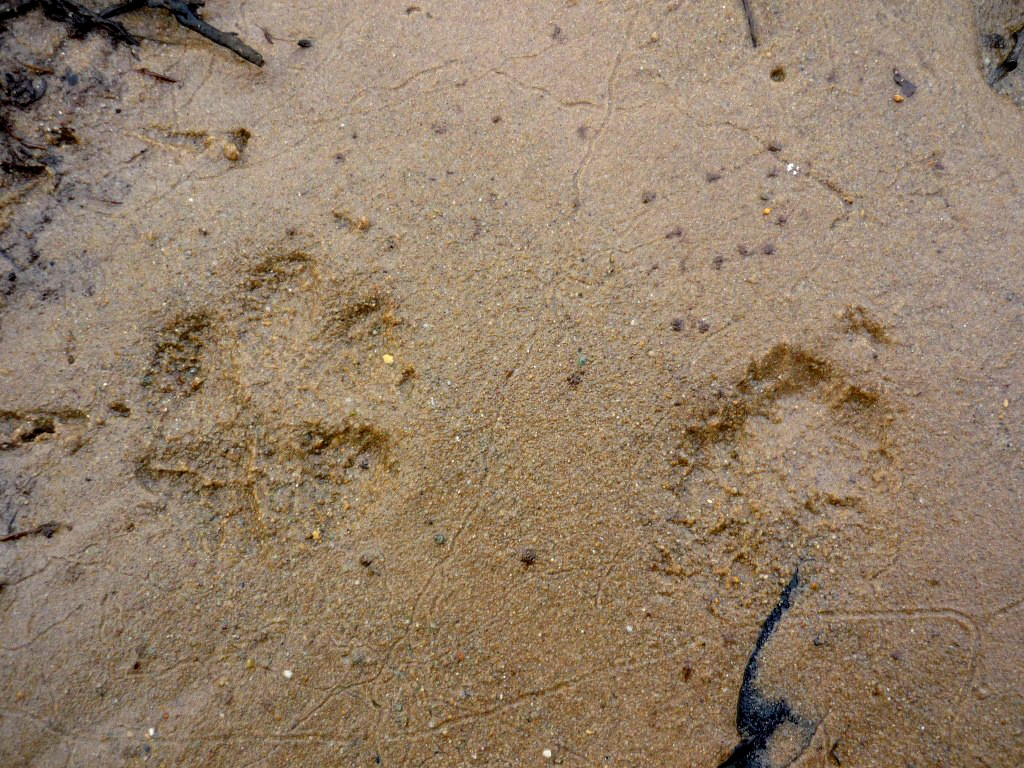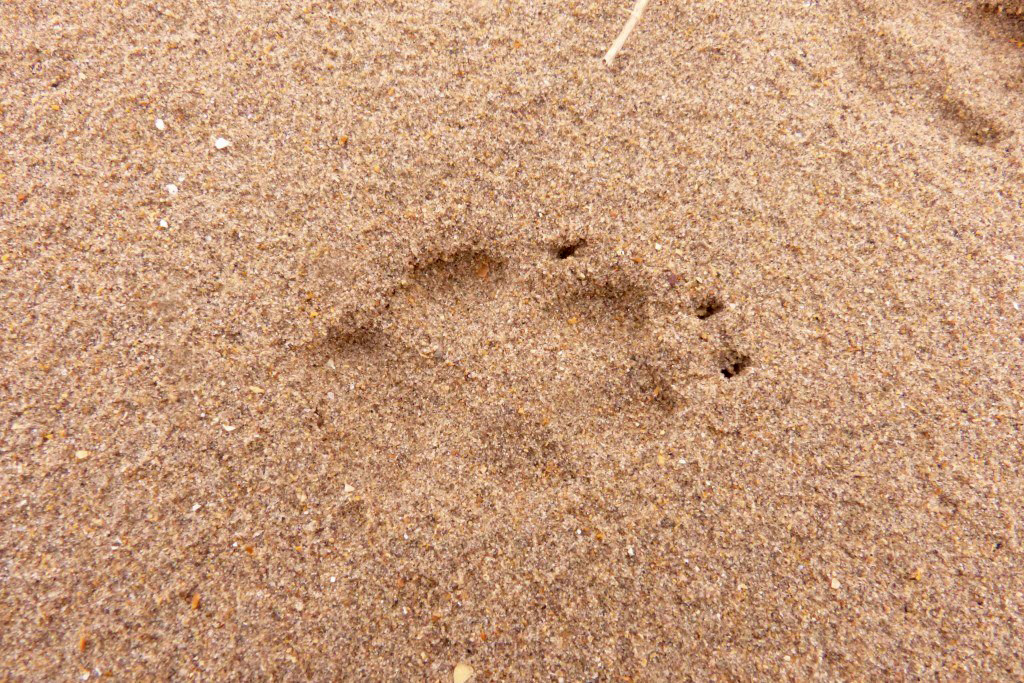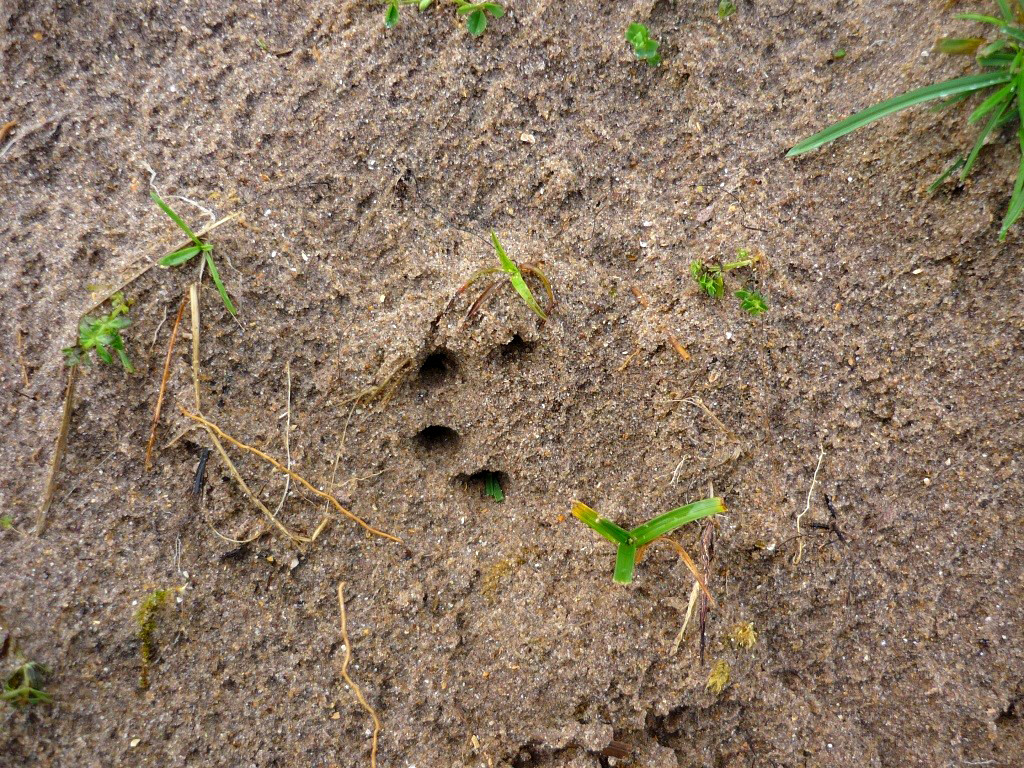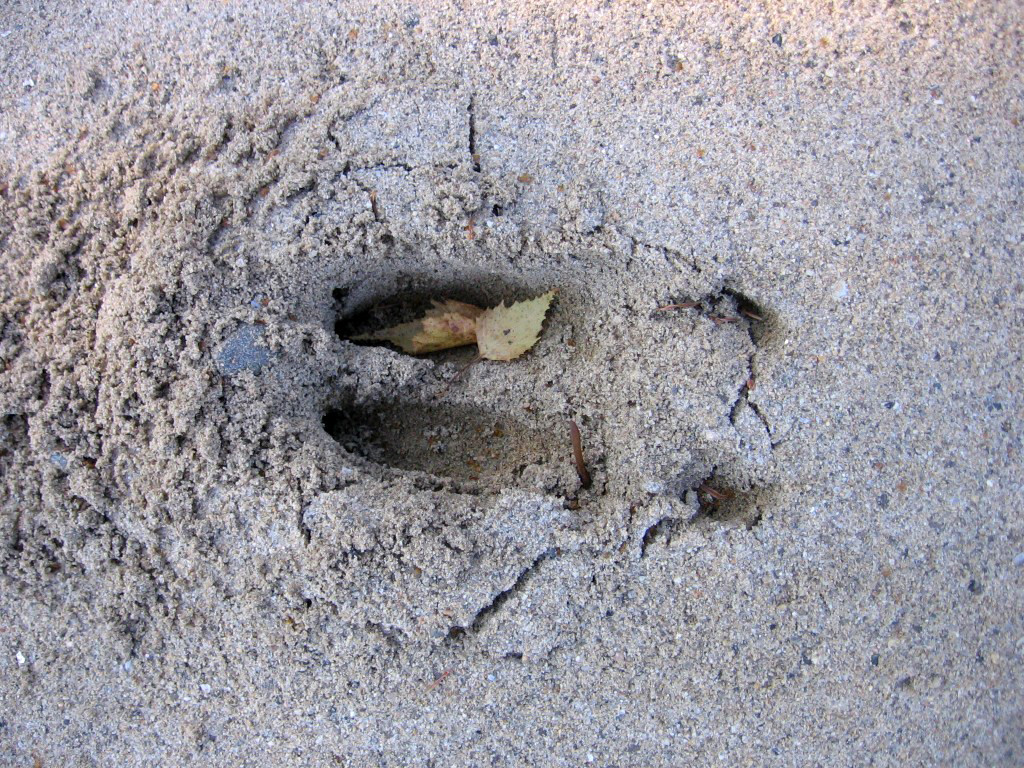By Sean Fagan

The red fox fore print on the left is reasonably visible but the rear print to right of photo is more faint. Often, when tracking the reality is most animal tracks are most similar to the fox rear print on the right i.e. faint and partial! (Photo: Sean Fagan).
Are Partial Tracks Important?
.
One of the more challenging aspects of tracking is dealing with partial tracks. Partial tracks can be defined as tracks that show a part, but not all, of a track.
As a general rule, partial animal tracks are more common than complete tracks, and therefore, as aspiring trackers it's important to become competent in reading partial tracks because doing so will make you a much better, well-rounded tracker.
Of course, on some tracking substrates such as sandy beaches, snow-covered ground or muddy areas there is an abundance of complete tracks.
However, for the majority of landscapes, for most of the year, there is an absence of large swathes of soft substrates that yield an abundance of complete tracks.
Nevertheless, when an animal passes through a landscape, it will leave some trace, however minuscule, of its passing, and partial tracks are one of the many potential indicators that animals leave in their passage through a given area.
So how do we become good at reading partial tracks? This is an important question – and the answer, in a way, is simple – become very familiar with every detail of complete tracks. Then, when you see a partial track of a particular animal that you are familiar with as regards its complete tracks, you will recognise the various micro features of that partial track.
In this article I will explore three of the more common reasons why partial tracks occur.
- FIRM GROUND
It's sometimes a commonly held assumption among some trackers that animals cannot be tracked on firm ground. Tell that to a San Bushman tracking an antelope over rocky ground, knowing that his partner and children are patiently waiting back at camp with empty bellies.
Humans have been tracking animals over hard surfaces for a very long time. To be sure, tracking over firm surfaces is hard and challenging but well within the realm of possible. One of the tracking signs that animals leave on firm surfaces is partial tracks.
One of my favourite animals I like to track is the red fox, Vulpes vulpes. Usually, wherever red foxes occur, the partial tracks and to a lesser extent the complete tracks of red foxes can be found pretty much everywhere as foxes tend to wander far and wide when foraging for a meal.
The hardest part of a fox foot is its claws, and sometimes, on harder ground surfaces, the claws will register whereas the majority of the track (the softer heel pad and toes) will not register. So what you can get is a fox track with only claw marks showing. However, fox claws, when they occur in isolation, are quite recognisable – it’s just a matter of knowing what to look for.
First off, all foxes have four claws and the claws are usually quite sharp and narrow.
Secondly, the inner two claws often point inwards, towards each other, or are conspicuously parallel.
In addition, since the outer two claws are almost positioned on the outer edge of the track the can be used as an approximation of the width of the track. Fox tracks, on average, vary between 3-4cm wide.
Lastly, the outer toes are positioned further back, and down the side of the track.
Dog tracks, tend to have outer toes positioned more forward and alongside the inner two toes, almost in a shallow arc.
Fox and domestic dogs are closely related species and can have similar tracks so there is a risk of confusing the tracks of these two species, especially with dogs tracks that are of similar dimensions to fox tracks.
So if I see a partial track with four sharp claws, with the inner two claws pointing towards each other or parallel, with an approximate track width of 3-4cm, with the outer claws positioned a significant distance back and behind the inner two claws, then I know with some degree of certainty, that the claw marks belong to a red fox.
However, at this stage of the puzzle I want confirmation that it is a fox, and so begins my search for more fox tracks and sign in the immediate area.
Finding a partial track should be a spur onto further investigation.
Nevertheless, if you do find a partial print, then subsequently find other tracks and sign that reinforce your initial partial track – it can be a very gratifying experience and a good stepping stone in your learning curve as a tracker.
.

Red fox track on firm sand. The overall oblong shape of the track as well as the presence of the sharply pointed claws and 4 toes as well as the length and width of the track (in this case 5cm x 4cm) strongly indicates this is a fox track (Photo: Sean Fagan).
.
.
2. HAIR-COVERED HEEL & TOE PADSAside from hoofed mammals most mammal tracks consist of three parts – the heel pad, toe pads and claws. Some mammal species have hair covering the heel and toe pads and are often not visible in tracks.
For example, the lagomorphs (rabbits, hares & pikas) have exceptionally hairy soles and the only distinct, recognisable feature of most hare and rabbit prints are the claws, which are small and do not exceed the overall compression print of the track.
Sometimes, on soft, moist ground such as mud the hairs can be seen in the track but more often than not the hairs are not visible. What is usually left is an overall impression and outline of the track with the claws being distinctly visible. Sometimes, all that is left is just claw marks.
.

Rabbit claws...note how short the claws are and how aligned within a tight semi-circle the claws are? Note also the absence of a visible heel pad and toes? (Photo: Sean Fagan).
Most animal species tend to leave partial tracks when they are moving quickly.
Try this – next time you are out on a beach, sprint a short distance. Then go back and look at your tracks. What you will find is that your toes left a large impression in the sand and your heel is more of less absent from the prints.
What happened is that you ran on your toes. The same principle of running on your toes (without the heel showing) occurs with most animal tracks when they run fast.
Deer, for example, leave partial tracks when moving at speed.
The front part of their hooves is firmly embedded in the soil but the rear edge of the hooves is often absent. Sometimes the dew claws (redundant toes located high up on the rear of the legs) are present. In addition the hooves are usually widely spread when the deer runs quickly, which gives the animal more stability when moving at high speed over variable terrain.
So, sometimes, partial prints can tell us how fast an animal is moving and you may be forgiven for thinking – so what? When we find tracks that indicate an animal was moving at a fast speed it tells us something dramatic occurred for the animal to feel compelled to move quickly, because most animals for the vast majority of time don’t move fast unless compelled to do so (because running fast is an energy-consuming, injury-prone business).
As trackers we are interested in interpreting behaviour from tracks - not just positively identifying the species of animal that left a track.
.

The tracks of a red deer moving fast. The rear edge of the hooves is barely discernible but the pointed tips and dew claws are very prominent as well as a considerable amount of displaced sand in front of the track - all indicators of a hooved animal moving fast over sand (Photo: Sean Fagan).
Finishing Thoughts...
.So there you have it, three reasons why animals produce partial tracks...
- hard ground surface
- hair-covered heel and toe pads
- moving at a fast speed.
There are other reasons as to why animals produce partial tracks and I will cover that topic in a later article.
However, the take-home message of this article is that reading partial tracks is a skill well worth adding to your repertoire of tracking skills.
Don’t be daunted by the process of committing to memory a vast store of partial track details, because reading partial tracks is a natural extension of reading complete tracks – however, by making an extra conscious effort in examining complete tracks you will greatly enhance your ability to read partial tracks wherever they may occur.
It'll be well worth the effort.
Imagine being able to positively identify a fox track from a single claw mark or a cat from a partial print of its heel pad? Both of these scenarios and much more, are well within the realm of possible for the dedicated tracker.
.
.
Related articles on this website:
.
*Check us out on Instagram, Twitter & Facebook for more outdoor-related topics.

Recent Comments